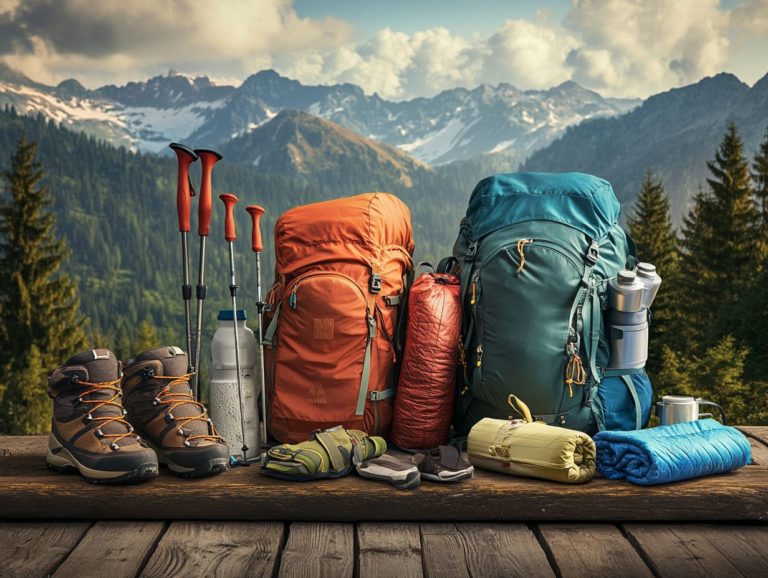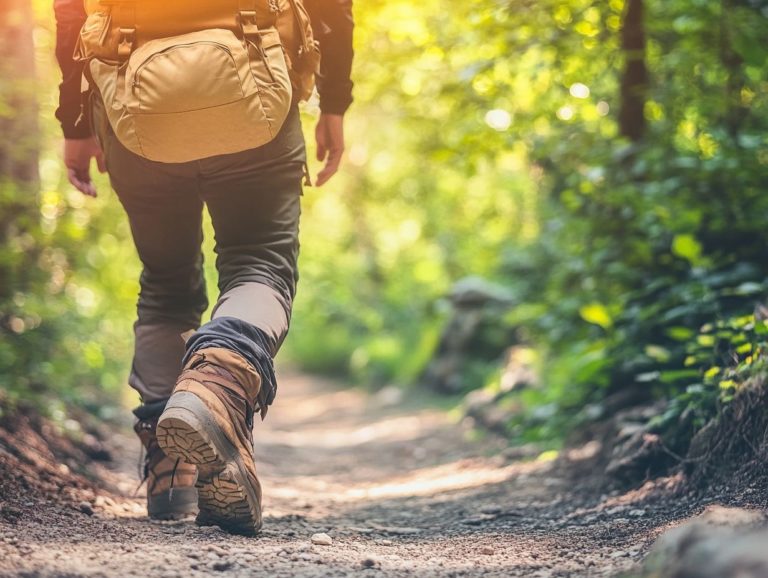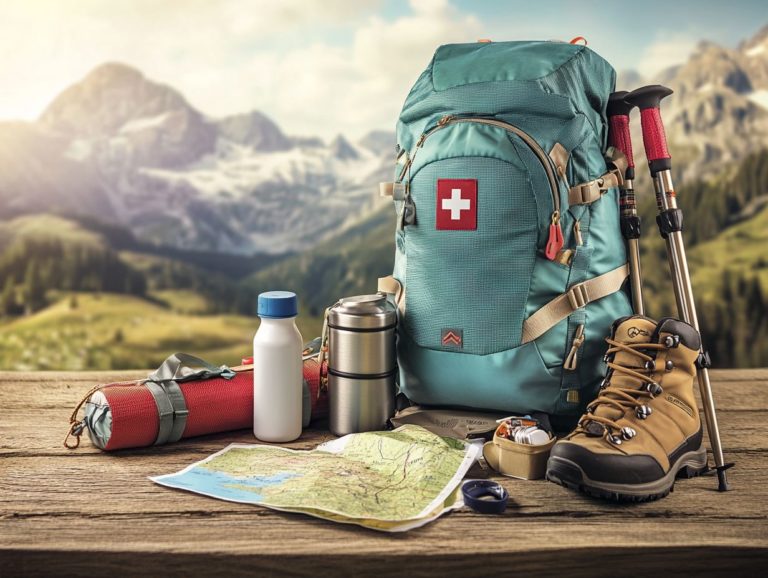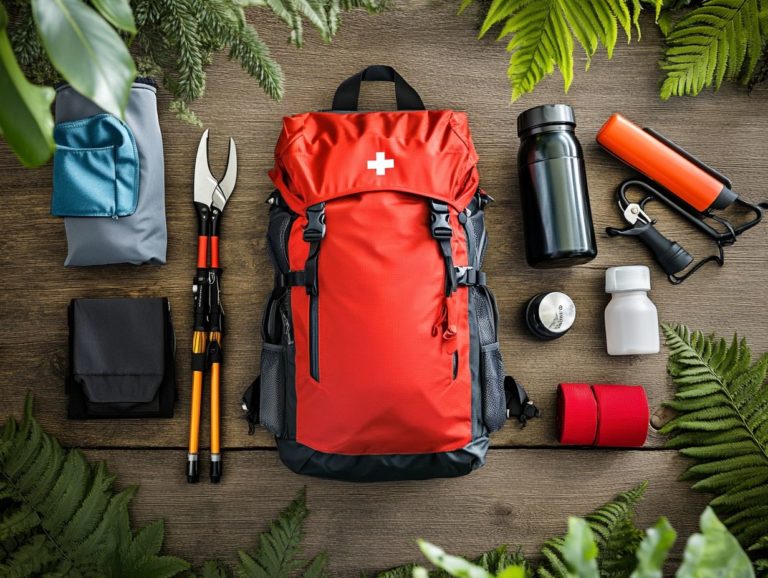A Beginner’s Guide to Thru-Hiking
Thru-hiking is an exciting adventure waiting for you! It combines physical challenges with mental focus, fostering a deep connection to the natural world.
Whether you’re planning your first multi-day trek or you’re a seasoned backpacker ready to tackle an entire trail, preparing for a thru-hike can feel exhilarating yet nerve-wracking.
This guide will clarify what thru-hiking involves, highlighting its numerous benefits, essential preparation strategies, and vital safety practices.
From choosing the right trail to understanding Leave No Trace principles respecting nature and not leaving trash behind you ll find everything you need to begin this unforgettable journey.
Contents
- Key Takeaways:
- What is Thru-Hiking?
- Benefits of Thru-Hiking
- How to Prepare for a Thru-Hike
- Choosing the Right Thru-Hike
- Thru-Hiking Logistics
- Staying Safe on the Trail
- Thru-Hiking Etiquette and Leave No Trace Principles
- Frequently Asked Questions
- What is thru-hiking and how is it different from regular hiking?
- Do I need any special gear for thru-hiking?
- How physically fit do I need to be to thru-hike?
- How much does thru-hiking typically cost?
- What safety precautions should I take while thru-hiking?
- Do I need any special permits or permissions to thru-hike?
Key Takeaways:

- Thru-hiking offers both physical and mental health benefits, making it a great activity for outdoor enthusiasts.
- Proper preparation is crucial for a successful thru-hike, including physical training and the right gear.
- Respecting nature and following Leave No Trace principles helps preserve the trail for future hikers.
What is Thru-Hiking?
Thru-hiking is a remarkable form of long-distance hiking that invites you to walk an entire trail in one continuous journey, often requiring months of dedicated effort and careful planning.
Some of the most well-known routes include the Appalachian Trail, the Pacific Crest Trail, and the Continental Divide Trail. Each path presents its own unique challenges and offers breathtaking landscapes that captivate the senses.
This adventure challenges you physically and connects you deeply with nature, providing invaluable opportunities for self-discovery. For many outdoor enthusiasts, it becomes a transformative experience that leaves a lasting impact.
Definition and Overview
Thru-hiking is different from day hiking or section hiking because you walk the entire trail without stopping, often covering hundreds to thousands of miles. A typical thru-hike can last from a few weeks to several months, depending on the specific trail and your pace.
Thorough preparation is essential; you must choose gear that balances weight and durability while planning resupply points locations where you can refill your food and supplies along your journey.
Embracing this experience offers a profound connection to nature, a sense of accomplishment, and opportunities for self-discovery as you face the physical and mental challenges of the trail.
Benefits of Thru-Hiking
Engaging in thru-hiking brings benefits that extend well beyond physical fitness; it positively influences mental health and nurtures a deep appreciation for the outdoors.
This immersive experience allows you to escape daily stress, encouraging mindfulness through nature and enhancing overall well-being.
As you navigate varied terrains and bond with vibrant hiking communities, you may find yourself gaining self-confidence, resilience, and motivation.
The journey becomes not only a physical challenge but also a rewarding opportunity for personal growth.
So why wait? Start planning your own thru-hike adventure today!
Physical and Mental Health Benefits
Thru-hiking is an amazing way to improve your physical health. It also nurtures your mental well-being. It offers an exceptional cardiovascular workout and fosters a deep connection with nature, providing ample opportunities for introspection.
Participants often report significant improvements in their overall fitness levels. As you embark on long-distance trails, you ll likely notice increases in your endurance and strength. Studies indicate that hikers can enhance their aerobic capacity, or the body s ability to use oxygen during exercise, by as much as 15% within just a few months.
The rhythmic movement paired with breathtaking landscapes works wonders in reducing stress levels. In fact, over 70% of hikers report a marked improvement in their emotional well-being after hitting the trails.
Anecdotal evidence from the hiking community is filled with personal stories of individuals discovering clarity and emotional resilience amidst the beauty of nature. These experiences showcase the diverse benefits that wandering along remote paths can bring to your life.
How to Prepare for a Thru-Hike

Preparing for a successful thru-hike requires careful planning. You need to focus on both training and the right gear!
A solid training plan typically includes cardio workouts, strength training, and practice hikes to build your endurance and facilitate proper acclimatization.
Choosing the right hiking gear is also crucial. Grasping the logistics of your journey and familiarizing yourself with trail safety are essential elements that contribute to a fulfilling and safe experience on renowned trails like the Appalachian Trail, Pacific Crest Trail, and Continental Divide Trail, guided by hiking organizations. To get started, make sure you have the essential hiking gear for beginners.
Physical Training and Gear Preparation
Physical training for a thru-hike should center around building your endurance, strength, and flexibility. Gear preparation involves carefully selecting the essential hiking equipment that will ensure your journey is successful.
To achieve this, you can incorporate specific exercises like long-distance walking or jogging, cycling, and weight training. Dedicate at least three to five days a week to these activities over several months to set yourself up for success. Adding yoga or stretching routines will enhance your flexibility, which is crucial for navigating the diverse terrains you ll encounter.
Equally important is ensuring you have the right equipment. A well-fitting backpack, a weather-appropriate sleeping bag, and reliable camping gear are vital components of your adventure. Consider items like trekking poles to aid your balance. Don’t underestimate the importance of proper footwear to prevent blisters and discomfort.
By balancing rigorous physical training with thoughtful gear selection, you ll be thoroughly prepared for the challenges that await you on the trail.
Choosing the Right Thru-Hike
Selecting the perfect thru-hike is a crucial decision influenced by several key factors, such as your personal fitness level, preferred hiking routes, and the environmental conditions you wish to explore.
Each trail has its own unique allure. For example, the Appalachian Trail enchants with its lush forests and diverse wildlife. The Pacific Crest Trail dazzles with breathtaking views of majestic mountains and arid deserts. The Continental Divide Trail, in contrast, beckons adventurers with its remote wilderness and challenging terrains.
Choosing the right trail not only guarantees an enjoyable journey but also aligns seamlessly with your personal hiking goals and aspirations.
Start planning your own thru-hike adventure today!
Factors to Consider
When selecting a long-distance hiking path, it s essential to weigh factors like trail conditions, weather, and your individual hiking challenges. These elements significantly shape your overall experience.
Choosing the right trail requires thoughtful examination. For example, terrain difficulty can differ dramatically. Some trails feature steep ascents and rocky pathways, demanding robust leg muscles and endurance, while others offer gentle slopes perfect for beginners.
Experienced hikers often suggest using online resources and local trail guides to assess the technical components of a hike. For those new to the activity, beginning your hiking journey can provide essential tips. Being aware of expected weather patterns is crucial; sudden storms or extreme temperatures can quickly transform a pleasant adventure into a perilous outing.
Stories from seasoned hikers underscore the necessity of checking weather forecasts and trail reports before your journey. It s vital to realistically evaluate your fitness levels. A challenging route may grab your attention, but selecting a trail that matches your capabilities will lead to a more enjoyable experience.
Thru-Hiking Logistics
Planning your thru-hike? It s all about the details! Thru-hiking logistics involve meticulous planning for food, water, and shelter crucial elements that guarantee a safe and enjoyable journey on the trail.
By prioritizing these essentials, you enhance your outdoor experience and set the stage for memorable adventures.
Planning for Food, Water, and Shelter

Proper planning for food, water, and shelter is essential for your success on a thru-hike. These elements greatly influence your overall hiking experience.
Without adequate preparation, you might encounter unexpected challenges that could detract from your adventure. Be sure to:
- Pack lightweight, nutrient-dense options like:
- Dehydrated meals
- Nuts
- Energy bars
Scouting the trail for reliable water sources like streams or springs ensures you stay hydrated throughout your journey. Choosing a suitable campsite, ideally located away from wildlife paths and at a safe distance from water, allows for restful nights while minimizing your environmental impact.
Incorporating compact cooking gear, such as a lightweight stove and quick-cook meals, can streamline meal prep, making it easier to refuel for the miles ahead.
Staying Safe on the Trail
Staying safe on your adventure is your top priority! It demands a keen awareness of potential hazards and the implementation of essential precautions and emergency protocols.
By understanding trail safety practices, you can significantly enhance your preparedness for the challenges that may arise. Identify risks such as wildlife encounters and adverse weather conditions, and equip yourself with the right gear.
Craft a solid emergency plan that includes navigation strategies, such as using GPS (Global Positioning System) and trail maps. Gear recommendations and communication methods will provide you with peace of mind and safety during your adventures, allowing you to explore stunning landscapes.
Precautions and Emergency Protocols
To ensure your safety during a thru-hike, it’s essential to grasp and implement various precautions and emergency protocols to reduce risks on the trail.
Effective navigation skills are very important. Use maps that show land features, a compass, or GPS to avoid getting lost.
Recognizing potential hazards, such as unstable terrain and sudden weather shifts, will empower you to react swiftly and effectively.
It s also prudent to develop an emergency plan for hiking safety. This includes packing a well-stocked first aid kit and familiarizing yourself with the locations of nearby shelters or resources, such as the National Park Service or local hiking organizations.
By acquainting yourself with these guidelines, you can ensure a safer and more enjoyable hiking experience.
Thru-Hiking Etiquette and Leave No Trace Principles
Understanding thru-hiking etiquette and Leave No Trace principles is essential for preserving the integrity of natural spaces and nurturing positive relationships within hiking communities. Leave No Trace means respecting nature by minimizing your impact.
Following these guidelines enhances your hiking experience and helps protect nature, ensuring that everyone can relish the serenity and adventure found in long-distance hikes.
Respecting Nature and Fellow Hikers
Respecting nature and fellow hikers lies at the core of responsible thru-hiking etiquette, making your outdoor adventures fun for everyone!
You can demonstrate this respect through various actions, such as sticking to marked trails to minimize your environmental impact and embracing Leave No Trace principles to preserve natural beauty for future visitors.
Mind your noise levels by keeping conversations and music at a respectful volume to maintain the serene atmosphere many seek. Yielding the trail to those ascending or those carrying larger backpacks needed for multi-day hikes fosters a sense of community and cooperation among hikers.
Even simple gestures, like greeting fellow adventurers or offering assistance, can transform an ordinary trek into a memorable journey, enriching the overall ambiance of camaraderie among hikers.
Frequently Asked Questions

What is thru-hiking and how is it different from regular hiking?
Thru-hiking is a long-distance hiking experience that involves hiking a trail or route continuously from start to finish, typically over several months. Unlike regular hiking, which can last a few hours or a day, thru-hiking requires extended periods of time on the trail and typically covers hundreds or thousands of miles.
Do I need any special gear for thru-hiking?
Yes, thru-hiking requires specific gear and equipment to ensure your safety and comfort on the trail. This includes a sturdy and lightweight backpack, a quality tent or shelter, a sleeping bag and sleeping pad, proper clothing and footwear, and other essential items such as a water filtration system and a stove for cooking meals.
How physically fit do I need to be to thru-hike?
While being physically fit can definitely make the experience more enjoyable, you don’t need to be an elite athlete to thru-hike. It’s important to gradually build up your endurance and strength before attempting a thru-hike, but the trail will also condition your body as you go.
Protect our beautiful trails now for future hikers! Gear up for your next adventure! Start planning today!
How much does thru-hiking typically cost?
The cost of thru-hiking varies widely. On average, expect to spend between $1,000 and $5,000 on gear, food, and other expenses.
Budgeting and planning are crucial steps before starting your hike. The more prepared you are, the more enjoyable your adventure will be!
What safety precautions should I take while thru-hiking?
Safety is your top priority on the trail. Be ready for bad weather, and always carry a first aid kit, which includes basic medical supplies.
Inform someone about your hiking plans and check in with them regularly. This simple step can make a big difference in your safety.
Do I need any special permits or permissions to thru-hike?
Some trails require permits or special permissions. Make sure to research and gather any necessary paperwork before you head out.
Also, respect any restrictions or closures in certain areas for your safety and to protect the environment.





